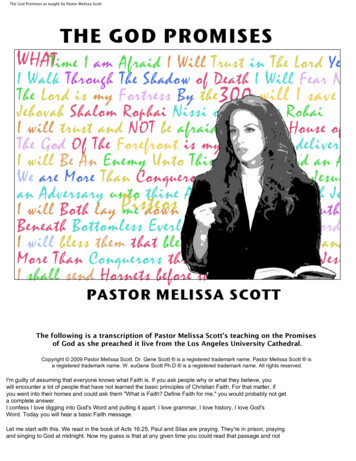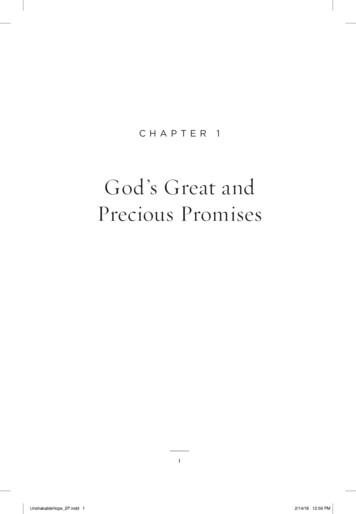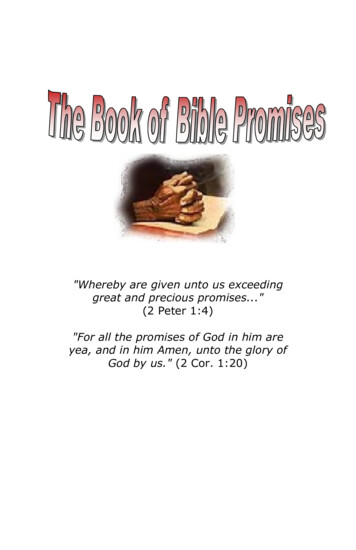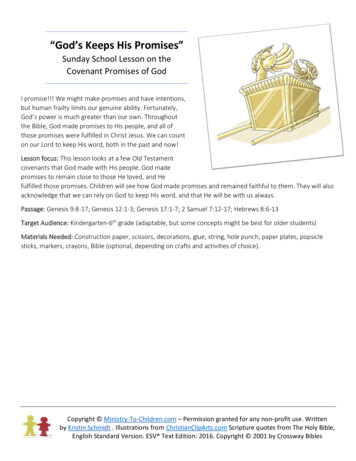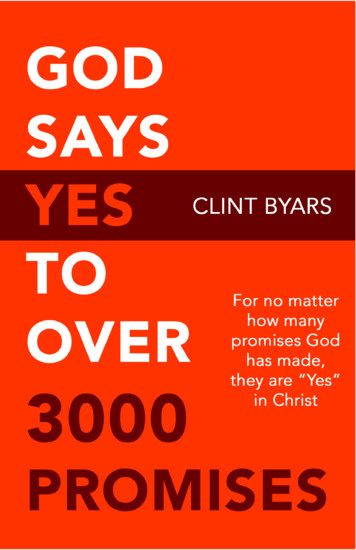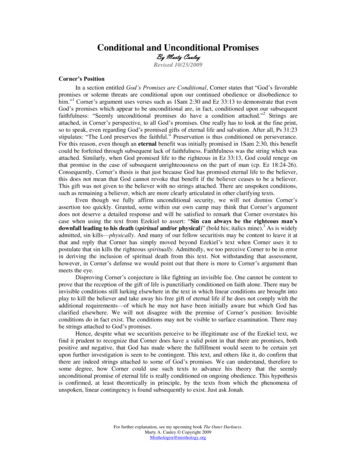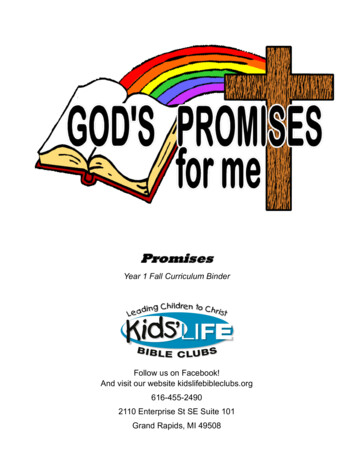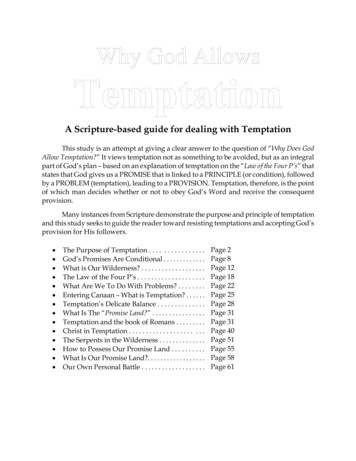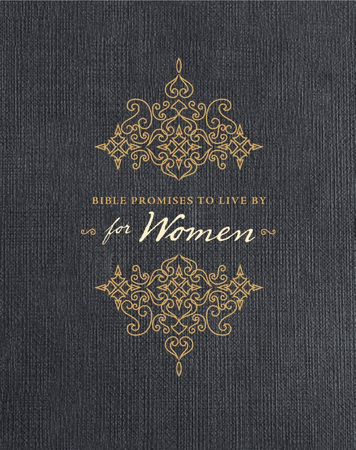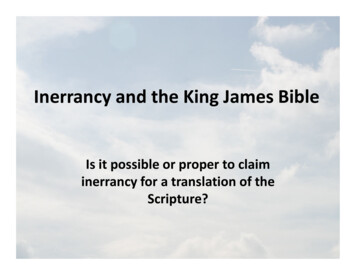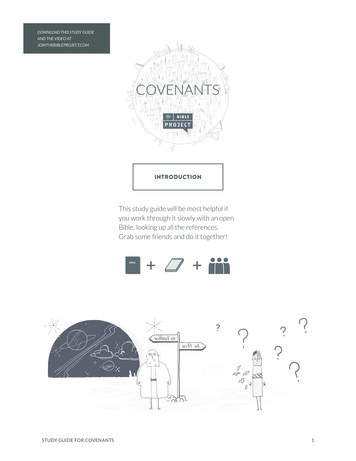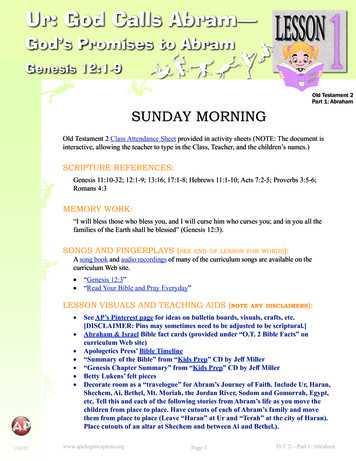
Transcription
Ur: God Calls Abram—God’s Promises to AbramLESSONGenesis 12:1-91Old Testament 2Part 1: AbrahamSUNDAY MORNINGOld Testament 2 Class Attendance Sheet provided in activity sheets (NOTE: The document isinteractive, allowing the teacher to type in the Class, Teacher, and the children’s names.)SCRIPTURE REFERENCES:Genesis 11:10-32; 12:1-9; 13:16; 17:1-8; Hebrews 11:1-10; Acts 7:2-5; Proverbs 3:5-6;Romans 4:3MEMORY WORK:“I will bless those who bless you, and I will curse him who curses you; and in you all thefamilies of the Earth shall be blessed” (Genesis 12:3).SONGS AND FINGERPLAYS (seeend of lesson for words):A song book and audio recordings of many of the curriculum songs are available on thecurriculum Web site. “Genesis 12:3”“Read Your Bible and Pray Everyday”LESSON VISUALS AND TEACHING AIDS (note 1/13/22any disclaimers):See AP’s Pinterest page for ideas on bulletin boards, visuals, crafts, etc.[DISCLAIMER: Pins may sometimes need to be adjusted to be scriptural.]Abraham & Israel Bible fact cards (provided under “O.T. 2 Bible Facts” oncurriculum Web site)Apologetics Press’ Bible Timeline“Summary of the Bible” from “Kids Prep” CD by Jeff Miller“Genesis Chapter Summary” from “Kids Prep” CD by Jeff MillerBetty Lukens’ felt piecesDecorate room as a “travelogue” for Abram’s Journey of Faith. Include Ur, Haran,Shechem, Ai, Bethel, Mt. Moriah, the Jordan River, Sodom and Gomorrah, Egypt,etc. Tell this and each of the following stories from Abram’s life as you move thechildren from place to place. Have cutouts of each of Abram’s family and movethem from place to place (Leave “Haran” at Ur and “Terah” at the city of Haran).Place cutouts of an altar at Shechem and between Ai and Bethel.).www.apologeticspress.orgPage 1O.T. 2—Part 1: Abraham
“Map of Abram’s Journeys” (provided in the map section of the curriculum site)A Beka Flash-A-Card Series: Abraham and Isaac (DISCLAIMER: use the cards, notthe lesson book)Abraham images from freebibleimages.com (DISCLAIMER: some representations maybe biblically inaccurate)PERSONAL APPLICATION:I may not always understand what God in His Word asks me to do, but if I study the Bible and trymy hardest to obey, He has promised to bless me, just as He did Abram.LESSON STARTS HEREINTRODUCTION: (YOUNGER CHILDREN)Have you ever been on a trip? (Discuss) What did you pack? We are going to study about a manthat moved to a new home just because God told him to! His name was Abram. (Later his namewas changed to Abraham.) How does God talk to us? We can’t hear His voice like Abram, but wecan study and obey the Bible just like Abram obeyed God.INTRODUCTION: (OLDER CHILDREN)What is faith? How do we show we have faith in God? (We obey His commands.) We talk alot about faith and obedience. Sometimes it’s hard to understand these words. To have faith insomeone means to trust him. The best way to understand faith and obedience is to see them inaction. This lesson teaches us about the meaning of these words by showing the actions of Abramwho would later become Abraham. He is known as the “Father of the Faithful” because of hisgreat faith in God.POINTS TO EMPHASIZE:1. For younger children: The teacher should focus on God telling Abram to move to the land ofCanaan. He and Sarai moved and obeyed God. Focus on the three promises made. It wouldbe good to have an object to represent each promise (baby or child figurine, picture of land ofCanaan, and picture of Jesus). Focus on how we can obey God like Abram.2. Eight generations after the Flood (about 300 years), there was a man named Terah who lived inthe land called “Chaldea” (later known as Babylon), between the Tigris and Euphrates Rivers.Terah had three sons: Abram, Nahor, and Haran (Haran died in Ur. Nahor married his niece,Milcah, had eight children, and remained in Mesopotamia).3. From Stephen’s comments in Acts 7, and Moses’ account of these events in Genesis 11 and 12,we learn that God spoke to Abram while he was in Ur of the Chaldees and told him to leave hisfamily and his country behind and to go to an unknown land—a land that God Himself wouldshow Abram. Abram took his father Terah and his nephew Lot with him. They went as far asHaran, into another idol-worshipping civilization. Abram would have been considered a veryunusual man to worship the one true God in that place, at that time.Ur: God Calls Abram—God’s Promises to AbramPage 2
RECOMMENDED READING FOR TEACHERS: See the articles “How Old was Terahwhen Abraham was Born?” and “Terah Begot Abraham—When?” by Eric Lyons onthe Apologetics Press Web site for responses to alleged Bible contradictions regardingthe birth of Abraham.4. After some time, Terah died and Abram left Haran, continuing on his journey. He was 75 years oldwhen he, his wife Sarai, his nephew Lot, and their servants left Haran. Abram and his family lefta very civilized area of the world to move from place to place for almost 25 years (Discuss what itmust have been like to leave a house to live in a tent, and to leave the conveniences of a “modern”city for deserted areas, etc.).5. God made Abram three very special promises, which would be repeated by God to Abram at least threetimes, then later to his son Isaac and his grandson, Jacob. The three promises were:A. God would give him many descendants (children, grandchildren, etc.).B. God would give him a special land for his descendants (Canaan).C. God would bless everyone in the world through one of Abram’s descendants: One whowould be the Savior of the world.RECOMMENDED READING FOR TEACHERS: See the article “The PredictedMessiah” by Kyle Butt on the Apologetics Press Web site for further study on O.T.predictions about the Messiah (i.e., Jesus).6. Abram believed God’s promises and responded in faith, doing just as God asked him to do, eventhough it would be many, many years before the promises were fulfilled.7. They journeyed southward to Shechem, then to a place between Bethel and Ai. At each place, Abrambuilt an altar to worship the Lord.8. There are some commands God has given us in the New Testament that we may not understand, butit is very important to obey, no matter what we think or feel. We must trust God. What is trust? Trustis having faith and confidence in someone else and what he says. Trust gives us a feeling of safetyand security, without fear. If we believe and trust God, we will choose to obey (Example: baby birdsor ducks following their mother).PRE-CLASS ACTIVITIES/LEARNING CENTERS (to be used as children arearriving—before class, and up to the first five minutes of class; or as homework): Click here for complete Activity Book and Answer Key.Ages 2-5: “The Story of Abram Coloring Sheet” (provided in activity sheets)To illustrate trust, teacher leads blindfolded (or have them close their eyes) children around theroom.Have adults come and act out the story (especially Genesis 11 and 15:1-21). Or let children act outstory.Bring a suitcase and clothes or items you would take on a trip and let children pack the suitcase.Page 3O.T. 2—Part 1: Abraham
The teacher could ask simple review questions and each time a child answers correctly, he orshe could put something in.Cut a suitcase out of construction paper and cut items out of magazines that you would takeif you were moving like Abram. Have children pick items to put in their suitcase or glue onit. The four and five year olds could cut their own out of magazines. (suitcase provided inactivity sheets)Laminate a donkey body cutout or glue it to a piece of cardboard, and let children color andattach clothespins to the donkey as legs so it will stand. Attach a paper to the donkey thatsays, “I am the donkey Abram rode the day when he listened to God and obeyed.” (Donkeycutouts provided in activity sheets: Color, Black and White)1st-2nd Graders: To illustrate trust, teacher leads blindfolded children around the room.Have students act out the story, especially Genesis 11 and 15:1-21 (or ask adults to comedo it).Have students lean back and fall into another’s arms (or something similar) to illustratetrust.“Map of Abram’s Journeys”: Let students put praying hands stickers on the map to indicateplaces Abram built altars. (map provided in map section of curriculum Web site)“The Story of Abram Crossword Puzzle” (provided in activity sheets)Books of the Bible Bingo. Can give students a blank bingo board [5 squares across and 5squares down for a total of 25 squares] and have them choose which books of the Biblethey put in their blanks—this way everyone’s board is different. Then have each book ofthe Bible written on a slip of paper, put the slips in a container, and draw them one at atime for the bingo game (Can reduce number of choices by only using first half of OT orNT books only, etc.). (Bingo card provided in activity sheets)3rd-4th Graders: Have the students read Genesis chapter 12 (and chapter 11, if they did not do so last week).[This could be assigned Sunday, to be completed by Wednesday.]Have the children read “Abraham Leaves a City to Go Camping” from Discovery magazine(April, 2017) [NOTE: Advanced Bible Reader quizzes exist for many issues of Discoverymagazine]Have the children read pp. 32-35 of Noah and the People of Faith, Contemporary BibleSeries, Scandinavia, Contemporary English Version (DISCLAIMERS: p. 8—change “givelife to” to “bring forth”; p. 13—remove “before the day is over” from the last sentence; p.20—change “destroy” to “rule over”; p. 24—change appropriate sentences to “every kind ofland animal ” and “Noah took males and females of every ”).Have the children read any of the following books: The Story of Abraham, by Maxine Nodel, Great Bible Stories, Baronet Books Abraham: Friend of God, by Penny Frank, The Lion Story Bible, Lion PublishingHave students act out the story, especially Genesis 11 and 15:1-21 (or ask adults to come do it).Have students lean back and fall into another’s arms (or something similar) to illustrate trust.“Map of Abram’s Journeys”: Make multiple-choice questions over Abram’s journey. (mapprovided in map section of curriculum Web site)Make flashcards with the following words: Terah, Abram, Nahor, Haran, Lot, Sarai, Ur,promises. Have students draw a card from a box/sack and tell what it had to do with the story.Ur: God Calls Abram—God’s Promises to AbramPage 4
“The Story of Abram Crossword Puzzle” (provided in activity sheets)Books of the Bible Bingo. Give students a blank bingo board (5 squares across and 5 squares downfor a total of 25 squares) and have them choose which books of the Bible they put in their blanks—this way everyone’s board is different. Then have each book of the Bible written on a slip of paper,put the slips in a container, and draw them one at a time for the bingo game. (Can reduce numberof choices, by only using first half of OT, NT books only, etc.). (Bingo card provided in activitysheets)SONGS:“GENESIS 12:3”Author: Jeff Miller(Tune: See “Hidden in My Heart” CD)“READ YOUR BIBLE AND PRAY EVERYDAY” (Click to Hear)Author: Unknown*If you read your Bible and pray everyday, you’ll grow, grow, grow. (REPEAT)Grow, grow, grow, grow,Grow, grow, grow.If you read your Bible and pray everyday, you’ll grow, grow, grow.(Make hand movements as if reading, praying, and like a child growing.)If you neglect your Bible and forget to pray, you’ll shrink, shrink, shrink.(Make hand movements as if closing Bible, head gesture saying “No,” and like a child shrinking.)(REPEAT)Shrink, shrink, shrink, shrink,Shrink, shrink, shrink.If you neglect your Bible and forget to pray, you’ll shrink, shrink, shrink.(Make hand movements as if closing Bible, head gesture saying “No,” and like a child shrinking.)So read your Bible and pray everyday, and you’ll grow, grow, grow.(Make hand movements as if reading, praying, and like a child growing.) (REPEAT)Grow, grow, grow, grow,Grow, grow, grow.So read your Bible and pray everyday, and you’ll grow, grow, grow.(Make hand movements as if reading, praying, and like a child growing.)*Author Unknown: Please contact us through the feedback button for this lesson if you are aware of anycopyright information for this song.*** IF YOU HAVE SUGGESTIONS PERTAINING TO THIS LESSON, PLEASE CLICK THE“SUGGESTION” BUTTON BESIDE THE BUTTON FOR THIS LESSON ON THECURRICULUM WEB SITE.Page 5O.T. 2—Part 1: Abraham
Ur: God Calls Abram—God’s Promises to AbramPage 6
Ur: God Calls Abram—God’s Promises to AbramLESSONGenesis 12:1-91Old Testament 2Part 1: AbrahamWEDNESDAY EVENINGOld Testament 2 Class Attendance Sheet provided in activity sheets (NOTE: The document isinteractive, allowing the teacher to type in the Class, Teacher, and the children’s names.)SCRIPTURE REFERENCES:Genesis 11:10-32; 12:1-9; 13:16; 17:1-8; Hebrews 11:1-10; Acts 7:2-5; Proverbs 3:5-6;Romans 4:3MEMORY WORK:“I will bless those who bless you, and I will curse him who curses you; and in you all thefamilies of the Earth shall be blessed” (Genesis 12:3).SONGS AND FINGERPLAYS (seeend ofSunday’slesson for words):A song book and audio recordings of many of the curriculum songs are available on thecurriculum Web site. “Genesis 12:3”“Read Your Bible and Pray Everyday”LESSON VISUALS AND TEACHING AIDS (note any disclaimers):See AP’s Pinterest page for ideas on bulletin boards, visuals, crafts, etc.[DISCLAIMER: Pins may sometimes need to be adjusted to be scriptural.]Abraham & Israel Bible fact cards (provided under “O.T. 2 Bible Facts” oncurriculum Web site)Apologetics Press’ Bible Timeline“Summary of the Bible” from “Kids Prep” CD by Jeff Miller“Genesis Chapter Summary” from “Kids Prep” CD by Jeff MillerBetty Lukens’ felt piecesDecorate room as a “travelogue” for Abram’s Journey of Faith. Include Ur, Haran,Shechem, Ai, Bethel, Mt. Moriah, the Jordan River, Sodom and Gomorrah, Egypt,etc. Tell this and each of the following stories from Abram’s life as you move thechildren from place to place. Have cutouts of each of Abram’s family and movethem from place to place (Leave “Haran” at Ur and “Terah” at the city of Haran).Place cutouts of an altar at Shechem and between Ai and Bethel.).www.apologeticspress.orgPage 7O.T. 2—Part 1: Abraham
“Map of Abram’s Journeys” (provided in the map section of the curriculum site)A Beka Flash-A-Card Series: Abraham and Isaac (DISCLAIMER: use the cards, not thelesson book)Abraham images from freebibleimages.com (DISCLAIMER: some representations may bebiblically inaccurate)PERSONAL APPLICATION:I may not always understand what God in His Word asks me to do, but if I study the Bible and try myhardest to obey, He has promised to bless me, just as He did Abram.INTRODUCTION/POINTS TO EMPHASIZE: Abraham & Israel Bible fact cards (provided under “O.T. 2 Bible Facts” on curriculum Web site) Review Sunday’s lesson (see O.T. 2 Review Questions for example questions)PRE-CLASS ACTIVITIES/LEARNING CENTERS (to be used as children arearriving—before class, and up to the first five minutes of class; or as homework): See Sunday morning’s lesson*** IF YOU HAVE SUGGESTIONS PERTAINING TO THIS LESSON, PLEASE CLICK THE“SUGGESTION” BUTTON BESIDE THE BUTTON FOR THIS LESSON ON THECURRICULUM WEB SITE.Ur: God Calls Abram—God’s Promises to AbramPage 8
Jordan River Valley:LESSONAbram Is Unselfish Toward LotGenesis 13:1-14:162Old Testament 2Part 1: AbrahamSUNDAY MORNINGOld Testament 2 Class Attendance Sheet provided in activity sheets (NOTE: The document isinteractive, allowing the teacher to type in the Class, Teacher, and the children’s names.)SCRIPTURE REFERENCES:Genesis 13:1-14:16; 1 Peter 3:8-9; Romans 12MEMORY WORK:“Let each of you look out not only for his own interests, but also for the interests of others”(Philippians 2:4).SONGS AND FINGERPLAYS (seeend of lesson for words):A song book and audio recordings of many of the curriculum songs are available on thecurriculum Web site. “Oh, Be Careful, Little Eyes, What You See”LESSON VISUALS AND TEACHING AIDS (note 1/14/22any disclaimers):See AP’s Pinterest page for ideas on bulletin boards, visuals, crafts, etc.[DISCLAIMER: Pins may sometimes need to be adjusted to be scriptural.]Abraham & Israel Bible fact cards (provided under “O.T. 2 Bible Facts” oncurriculum Web site)Apologetics Press’ Bible Timeline“Summary of the Bible” from “Kids Prep” CD by Jeff Miller“Genesis Chapter Summary” from “Kids Prep” CD by Jeff MillerBetty Lukens’ felt piecesA Beka Flash-A-Card Series: Abraham and Isaac (DISCLAIMER: use the cards,not the lesson book)“Map of Abram’s Journeys” (provided in the map section of the curriculum site)Figures glued or taped to popsicle sticks to stick in a large piece of Styrofoam as youtell the story, or Fisher-Price “Little People” and animals to use in a sandbox scene.(“The Story of Abram Cutouts” provided in activity sheets)Abraham images from freebibleimages.com (DISCLAIMER: some representationsmay be biblically inaccurate)www.apologeticspress.orgPage 9O.T. 2—Part 1: Abraham
PERSONAL APPLICATION:I cannot always have my own way or have the best for myself. I should always be willing toshare what I have. I should also always consider the effect of my decisions from a spiritual,rather than earthly, perspective.LESSON STARTS HEREINTRODUCTION: (YOUNGER CHILDREN)Last week, we talked about God telling a man to leave his home and move to a new place. Do youremember that man’s name? (Abram) Abram was a very good man. Today, we are going to studyabout Abram making a good choice.INTRODUCTION: (OLDER CHILDREN)Review last week’s lesson.Last week we talked about faith and trust in God, and how important it is to obey Him. Today weare going to learn that Abram made a very good choice. He chose not to be selfish.POINTS TO EMPHASIZE:1. Review the meaning of the word “faith” and how Abram showed his faith.2. In Bible times, a person’s wealth was determined by how much livestock he had. Abram andLot were both very wealthy men. Genesis 13 tells us that they each had so many animals thatthe area of land where they were living at that time could not provide enough food for all theanimals.3. Because there was not enough pasture for all the animals, the herdsmen of Abram and Lot(the servants who took care of all the animals in the fields) quarreled a lot. To keep the peace,Abram suggested that he and Lot no longer live in the same place. God had promised to giveAbram all the land of Canaan, but he was willing to share with Lot.4. Abram was Lot’s uncle; he was the leader of the family. So, he had the right to choose the bestland for himself and send Lot to whatever land was left.5. Not only was Abram willing to share, but he let Lot choose the land he wanted. Lot chose thevery beautiful, well-watered land around the Jordan River Valley and moved toward the citiesof Sodom and Gomorrah, south of the Dead Sea.6. Abram moved to the town of Hebron and built another altar to worship God. He did notcomplain or have bad feelings toward Lot because Lot chose the best land. Abram was ahappier man because he was unselfish and because he trusted God to take care of him.7. Lot did not make a wise choice about where he should live. The Bible says that when he leftAbram, he moved “toward Sodom.” Eventually he was living in Sodom. Sodom and Gomorrahwere very wicked places. They were definitely not good places to raise a family. Sometimeswhat we think is the “best” thing to have or do is not really the best when we think about itspiritually!Jordan River Valley: Abram is Unselfish toward LotPage 10
NOTE: The Bible does not tell us for certain, but Lot could possibly have married andraised his children after moving toward Sodom. The text seems to indicate that he wasthere for several years before any trouble started. Genesis 14:12 and 14:16 both mention“Lot and his possessions,” not “Lot and his family.”8. Talk about circumstances when we should let others go first (Romans 12:10, give “preference to oneanother”).With younger children, use pictures to illustrate those situations and ask them, “What wouldyou do?” and/or “What should you do?”With older children: Write the memory verse on the board. Erase one word at a time until theverse is gone. Then, see if the children can remember the entire verse and/or write it out.NOTE: Genesis 14:13 is the first mention of the word “Hebrew” in the Bible. Scholarsbelieve this word is a derivation of the name “Eber” (Genesis 10:21-25; 11:14-17),which appears to be related to a verb meaning “to cross over” or “to pass through.”RECOMMENDED READING FOR TEACHERS: See the article “Oh Brother.or is itNephew?” by Eric Lyons on the Apologetics Press Web site for a response to an allegedcontradiction regarding the identity of Lot.PRE-CLASS ACTIVITIES/LEARNING CENTERS (to be used as children arearriving—before class, and up to the first five minutes of class; or as homework): Click here for complete Activity Book.Ages 2-5: “Abram Is Unselfish Toward Lot Coloring Sheet” (provided in activity sheets)On half-sheets of cardstock or construction paper, glue simple drawings of characters in the storyand/or write one-word facts from the lesson. As you show each card to the children, tell them thesignificance of the person or fact. Then show the children the cards again, asking them to repeatwhat you told them. (“The Story of Abram Cutouts” provided in activity sheets)Have children sit in a circle, and discuss what it means to share. Tell the children that you broughta ball to share, and they need to share the ball, too. Roll the ball to someone, and ask the child areview question; when he answers, ask him to roll the ball to someone else. Repeat until everyonehas had one or more turns. (O.T. 2 Review Questions provided on curriculum Web site)Provide each child with a sheet of construction paper with the caption, “I can share like Abramshared with Lot.” Also provide them with pictures from magazines and catalogs of things they canshare (toys, books, snacks, etc.).1st-2nd Graders: On half-sheets of cardstock or construction paper, glue simple drawings of characters in the storyand/or write one-word facts from the lesson. As you show each card to the children, tell them thesignificance of the person or fact. Then show the children the cards again, asking them to repeatwhat you told them. (“The Story of Abram Cutouts” provided in activity sheets)Write sentences about the lesson on large index cards or sentence strips. Ask the children to putPage 11O.T. 2—Part 1: Abraham
them in the order they occurred. After the children have mastered this activity, add sentencesabout previous lessons.Play Tic-Tac-Toe with review questions (Instructions and Board provided in activity sectionof the site)3rd-4th Graders: Have the kids read Genesis chapters 13-14 (and chapters 11-12 if they did not read thosechapters the last two weeks). [This could be assigned Sunday, to be completed by Wednesday.]Write sentences about the lesson on large index cards or sentence strips. Ask the childrento put them in the order they occurred. After the children have mastered this activity, addsentences about previous lessons.Play Tic-Tac-Toe with review questions (Instructions and Board provided in activity sectionof the site)SONGS:“OH, BE CAREFUL LITTLE EYES WHAT YOU SEE” (Click to Hear)Author: Unknown*(Tune: See Internet)Oh, be careful little eyes what you see. (REPEAT)For the Father up above,Is looking down in love.So, be careful little eyes what you see.Oh, be careful little feet.Oh, be careful little ears.Oh, be careful little mouth.Oh, be careful little hands.*Author Unknown: Please contact us through the feedback button for this lesson if you are aware ofany copyright information for this song.*** IF YOU HAVE SUGGESTIONS PERTAINING TO THIS LESSON, PLEASE CLICKTHE “SUGGESTION” BUTTON BESIDE THE BUTTON FOR THIS LESSON ON THECURRICULUM WEB SITE.Jordan River Valley: Abram is Unselfish toward LotPage 12
Jordan River Valley:LESSONAbram Is Unselfish Toward LotGenesis 13:1-14:162Old Testament 2Part 1: AbrahamWEDNESDAY EVENINGOld Testament 2 Class Attendance Sheet provided in activity sheets (NOTE: The document isinteractive, allowing the teacher to type in the Class, Teacher, and the children’s names.)SCRIPTURE REFERENCES:Genesis 13:1-14:16; 1 Peter 3:8-9; Romans 12MEMORY WORK:“Let each of you look out not only for his own interests, but also for the interests of others”(Philippians 2:4).SONGS AND FINGERPLAYS (seeend ofSunday’slesson for words):A song book and audio recordings of many of the curriculum songs are available on thecurriculum Web site. “Oh, Be Careful, Little Eyes, What You See”LESSON VISUALS AND TEACHING AIDS (note any disclaimers):See AP’s Pinterest page for ideas on bulletin boards, visuals, crafts, etc.[DISCLAIMER: Pins may sometimes need to be adjusted to be scriptural.]Abraham & Israel Bible fact cards (provided under “O.T. 2 Bible Facts” oncurriculum Web site)Apologetics Press’ Bible Timeline“Summary of the Bible” from “Kids Prep” CD by Jeff Miller“Genesis Chapter Summary” from “Kids Prep” CD by Jeff MillerBetty Lukens’ felt piecesA Beka Flash-A-Card Series: Abraham and Isaac (DISCLAIMER: use the cards, notthe lesson book)“Map of Abram’s Journeys” (provided in the map section of the curriculum site)Abraham images from freebibleimages.com (DISCLAIMER: some representationsmay be biblically inaccurate)PERSONAL APPLICATION:I cannot always have my own way or have the best for myself. I should always be willing towww.apologeticspress.orgPage 13O.T. 2—Part 1: Abraham
share what I have.INTRODUCTION: Abraham & Israel Bible fact cards (provided under “O.T. 2 Bible Facts” on curriculum Website) Review Sunday’s lesson (see O.T. 2 Review Questions for example questions)POINTS TO EMPHASIZE:1. After some time, there was a war to the east and south of the Jordan River Valley. Four powerfulkings from the eastern part of the world (including as far away as Babylon, or Shinar) came tofight against five kings of the cities near the southern part of the Dead Sea—including Sodom.2. The kings of the East took control of cities on the eastern side of the Jordan River and Edomto the south. They turned northward to attack the cities in the Valley of Siddim, which includedSodom and Gomorrah. The kings of Sodom and Gomorrah tried to fight, but when they sawthat they were losing the battle, they tried to run away. Some of the people running away diedin and around the tar pits in the valley. (Pictures of the La Brea tar pits in Los Angeles will helpexplain what these natural formations were and how dangerous they were.)3. With the armies of Sodom and Gomorrah defeated, the kings of the East went through the citiestaking whatever they wanted. They also took many people as prisoners; among those prisonerswas Lot.4. A man was able to get away and tell Abram what had happened to his nephew Lot. Abramgathered 318 of his servants who were trained to fight, and they went from Hebron to Danwhere the armies of the East were. Abram’s tiny group of soldiers divided into groups, attackedthe enemy at night, and defeated them with God’s help. Abram rescued Lot and many others.5. Abram was very unselfish to go after Lot. He could have complained or offered many excusesfor why he should not help Lot. But he thought more about Lot’s safety and happiness than hedid his own.PRE-CLASS ACTIVITIES/LEARNING CENTERS (to be used as children arearriving—before class, and up to the first five minutes of class; or as homework): See Sunday morning’s lesson*** IF YOU HAVE SUGGESTIONS PERTAINING TO THIS LESSON, PLEASE CLICK THE“SUGGESTION” BUTTON BESIDE THE BUTTON FOR THIS LESSON ON THECURRICULUM WEB SITE.Jordan River Valley: Abram is Unselfish toward LotPage 14
Sodom and Gomorrah:Lot is in Bad Company3LESSONGenesis 18-19Old Testament 2Part 1: AbrahamSUNDAY MORNINGOld Testament 2 Class Attendance Sheet provided in activity sheets (NOTE: The document isinteractive, allowing the teacher to type in the Class, Teacher, and the children’s names.)SCRIPTURE REFERENCES:Genesis 13:11-13; 18:16-19:29; 2 Peter 2:6-8; Jude 7; 2 Peter 3:17MEMORY WORK:YOUNGER CHILDREN: “Evil company corrupts good habits” (1 Corinthians 15:33).OLDER CHILDREN: “Do not be deceived: ‘Evil company corrupts good habits’”(1 Corinthians 15:33).SONGS AND FINGERPLAYS (seeend of lesson for words):A song book and audio recordings of many of the curriculum songs are available on thecurriculum Web site. “Oh, Be Careful, Little Eyes, What You See”LESSON VISUALS AND TEACHING AIDS (note 1/13/22any disclaimers):See AP’s Pinterest page for ideas on bulletin boards, visuals, crafts, etc.[DISCLAIMER: Pins may sometimes need to be adjusted to be scriptural.]Abraham & Israel Bible fact cards (provided under “O.T. 2 Bible Facts” oncurriculum Web site)Apologetics Press’ Bible Timeline“Summary of the Bible” from “Kids Prep” CD by Jeff Miller“Genesis Chapter Summary” from “Kids Prep” CD by Jeff MillerBetty Lukens’ felt piecesA Beka Flash-A-Card Series: Abraham and Isaac (DISCLAIMER: use the cards,not the lesson book)“Map of Abram’s Journeys” (provided in the map section of the curriculum site)Use a magazine picture (or use one from clipart) of a lush, green landscape todescribe the area around the southern and western sides of the Dead Sea. Draw aball of fire to put over the cities at the appropriate time in the lesson. Cut a pieceof brown paper the same size as the lush landscape; lightly brush it with whiteglue and sprinkle salt over the glue. Use the brown paper to show the completewww.apologeticspress.orgPage 15O.T. 2—Part 1: Abraham
destruction of the cities.Does God Love Michael’s Two Daddies? by Sheila Butt, Apologetics PressSodom and Gomorrah images from freebibleimages.com (DISCLAIMER: somerepresentations may be biblically inaccurate)LESSON STARTS HERETEACHING ALERTS: Note that angels when on Earth are consistently portrayed as having the appearance of ahuman male (i.e., without wings; e.g., Genesis 18-19; Hebrews 13:2; Judges 13), thoughsometimes glowing/shining (e.g.,
Dec 16, 2021 · C. God would bless everyone in the world through one of Abram’s descendants: One who would be the Savior of the world. 6. Abram believed God’s promises and responded in faith, doing just as God asked him to do, even though it would be many, many year
